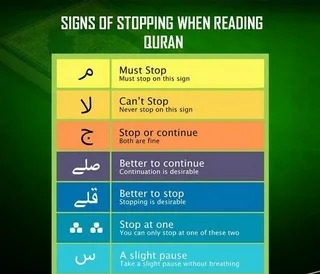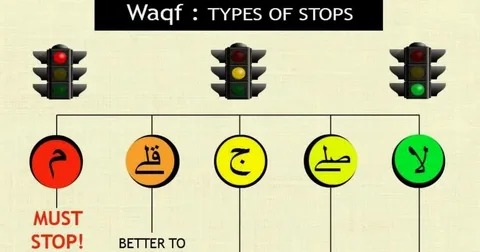In the world of Islam, the Quran holds a sacred place as the holy book, and its proper recitation is of utmost importance. Reading the Quran is not just about reciting the verses; it involves adhering to specific rules and etiquettes, one of which is knowing when and how to stop while reading. In this comprehensive guide on Arabian Tongue website, we will delve into what are the rules of stopping when reading Quran, ensuring that you can approach this spiritual practice with reverence and precision.
The Significance of Proper Recitation
Reciting the Quran is an act of worship, and it is believed that every letter of the Quran carries immense spiritual rewards. To make the most of this opportunity, it is essential to recite the Quran with precision and adhere to the rules of proper recitation.
what are the rules of stopping when reading quran

The Quran is not just a religious text; it is a divine guidance for Muslims worldwide. To ensure that its message is conveyed accurately, Muslims have developed specific rules and etiquettes for reciting the Quran. One crucial aspect of this practice is knowing when to pause or stop during the recitation.
1. Pausing at the End of a Verse
The most straightforward rule is to pause at the end of a verse. This allows the reader to take a breath and reflect on the message conveyed in that verse. The pause should be brief, and the next verse should follow seamlessly, know that rules of stopping when reading quran
2. Stopping at a Sajdah (Prostration) Point
In the Quran, there are specific points where prostration is recommended, known as sajdah points. When you come across these points, it is customary to stop and perform the sajdah. Afterward, you can continue from where you left off.
3. Rules for Stopping in the Middle of a Verse
If you need to stop in the middle of a verse, it is important to do so at a point that does not change the meaning of the text. This requires a good understanding of Arabic grammar and context. It is advisable to seek guidance from knowledgeable individuals to ensure accuracy.
4. Stopping with Proper Intention
When reading the Quran, it is essential to have the right intention. Your intention should be to seek guidance, gain knowledge, and draw closer to Allah. This intention will enhance the spiritual benefits of your recitation.
The Importance of Tajweed
Tajweed is the proper pronunciation and articulation of the Arabic letters and words in the Quran. It is essential to learn and apply Tajweed rules to ensure that your recitation is clear and accurate.
Reverence and Focus
When reciting the Quran, maintain an atmosphere of reverence and focus. Find a quiet and clean place, free from distractions, and dedicate your full attention to the recitation. This will deepen your connection with the text.
Common Mistakes to Avoid
Avoid rushing through the Quran or reading it in a hurried manner. Take your time to understand the verses and their meanings. Also, avoid improper pauses or interruptions that may alter the intended message.
Seek Knowledge and Guidance
If you are unsure about any rules or guidelines related to Quranic recitation, seek knowledge from qualified scholars or teachers. They can provide valuable insights and correct any mistakes you may be making.
A Harmonious Connection
Reading the Quran is not just about reciting words; it is about establishing a harmonious connection with the divine. Approach your recitation with humility, sincerity, and a yearning for spiritual growth.
Understanding the Symbols in the Quran

Before delving into the symbols and rules, let’s start with a brief overview of the Quran itself. The Quran is the holy scripture of Islam, believed by Muslims to be the word of God as revealed to the Prophet Muhammad over a period of 23 years. It is written in Arabic and consists of 114 chapters, known as Surahs, which vary in length and cover various aspects of faith, morality, and guidance for living a righteous life.
1. The Crescent Moon and Star
One of the most recognizable symbols associated with Islam is the crescent moon and star. While these symbols are not directly mentioned in the Quran, they have become widely associated with Islamic culture and are often used to represent the faith.
2. The Arabic Calligraphy
The Quran is renowned for its exquisite Arabic calligraphy. Each letter and word is meticulously written to convey not only the text’s meaning but also its artistic beauty. This calligraphy is a symbol of the Quran’s reverence and importance.
3. The Minaret
Minarets are tall towers often found near mosques, from which the call to prayer is made. These architectural structures are symbolic of the connection between the Muslim community and God, as well as the place where the Quran’s teachings are often recited.
4. The Kaaba
Located in the Holy City of Mecca, the Kaaba is a cubic building at the center of the Masjid al-Haram. It is a symbol of unity among Muslims worldwide and serves as the focal point of their prayers.
Rules and Guidelines for Interpreting the Quran
The Quran, often referred to as the holy book of Islam, is a profound and complex text that holds immense significance for Muslims around the world. While many people are familiar with its existence, there are numerous symbols and rules within the Quran that might appear enigmatic to those who are not well-versed in its teachings.
- Context is Key: Understanding the context in which a particular verse or passage was revealed is essential for proper interpretation. The historical and social context can significantly impact the meaning of the text.
- Interpretation by Scholars: The interpretation of the Quran is not left solely to individuals but is the domain of Islamic scholars. They study the text rigorously and provide guidance on its meaning and application.
- The Principle of Abrogation: In some instances, later verses of the Quran may supersede or abrogate earlier ones. This principle helps reconcile apparent contradictions in the text.
- The Importance of Language: Arabic is the original language of the Quran, and understanding its linguistic nuances is crucial for accurate interpretation. Even small variations in pronunciation can alter the meaning.
FAQs
Can I stop reading the Quran at any point?
No, it is essential to stop at appropriate points, such as the end of a verse or at sajdah points. Random stops in the middle of a verse should be avoided to maintain the integrity of the text.
What is Tajweed, and why is it important?
Tajweed is the proper pronunciation and articulation of Quranic words. It is crucial to maintain the accuracy and clarity of the recitation, enhancing the understanding of the text.
Are there any specific guidelines for women while reading the Quran?
Women are encouraged to observe the same rules and etiquettes as men while reading the Quran. The rules of stopping and recitation apply to both genders.
How can I improve my Arabic pronunciation when reciting the Quran?
Improving pronunciation requires practice and learning Tajweed rules. Consider seeking guidance from a knowledgeable teacher to refine your recitation.
Is it permissible to recite the Quran from memory?
Yes, it is permissible to recite the Quran from memory. However, it is still essential to follow the rules of proper recitation and stopping.
Conclusion
In conclusion, understanding the rules of stopping when reading the Quran is essential for every Muslim. It ensures that the divine message is conveyed accurately and that the spiritual benefits of recitation are maximized. By following these rules and etiquettes, you can deepen your connection with the Quran and draw closer to Allah.


